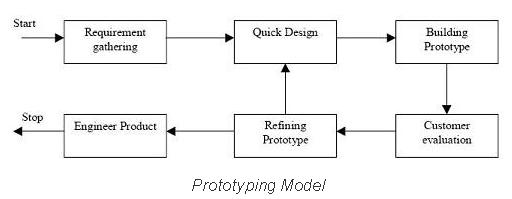Waterfall Model

Waterfall model refers to a linear and sequential process. The software development process from the top to the bottom of this model. The advantages of this process include simpleness, finiteness, and programmers can make a precise schedule to work with. The foremost disadvantage is that once the requirements of the software are set, programmers cannot change it anymore, and once a stage is completed, they cannot go back and make any modification.
Spiral Model

The most unique characteristic is its risk-driven approach as this model conduct risks identification process in each stage to progressively improve the software. There are four stages.The first stage is the identification of business, system, software, and hardware requirements. The second stage is Evaluation and Risk Analysis. The third stage is Development and Testing as programmers develop a new version of the software, called prototype according to new-identified risks and customers’ evaluations. The final stage is Plan next iteration includes design.
The advantage of this model is that its iterative framework helps to ensure there is no problem in the software and allows programmers to make changes. While the disadvantage is that its iterating process lasts infinitely and unpredictably.
Prototyping Model

The prototyping model is a restricted iterating process. Prototypes kept being refined by collecting customers’ evaluation. In this process, clients are actively involved and are enabled a more thorough understanding of the requirements. Errors are identified and detached earlier. However, this process increases the complexity of a project, nevertheless, it is more simple than the Spiral Model.
System Development Life Cycles
System Development Life Cycles has five stages: analysis, design, implementation, testing, evaluation.
System Analysis Stage is a fact-gathering method. We should first conduct a detailed observation of the system, then identify problems and find proper ways to solve them including interviews, observations, questionnaires, and examination of documents.
Interview Questions
- Can you explain me your problem?
- What do you not like / like about it?
- What do you want me to do to improve?
Questionnaires / Surveys
A closed (unrestricted) questionnaire only involves “yes” or “no” questions while a open (restricted) questionnaire only involves free response questions. An effective questionnaire should involve both close and open questions.
Design Stage concerns with determining how the NEW system will be created and separated.
Implementation stage refers to the installation of hardware and software is used when clients do not know how to install the required software as designers should provide clients a list of required software and hardware.
Black Box Testing only cares about the input and output, not the implementing process. White Box Testing is about checking the inside of the code. Dry Run Testing is about using debugger to check the inside of testing.
Stakeholder
Stakeholders are individuals, teams, groups or organization that have interests in the realization of a project or might be affected by the outcome of a project.
If I am producing an online Grade Book that can calculate the final score of each student according to scores teachers entered. Stakeholders are students, parents, school coordinators, school principal, technicians, system administrators, professional staff, security expert, network administrators, and most importantly, teachers who are also the main end-users.
End users
They are people who are going to use the program and programmers are always working towards end-users.
Consequences of failing to consider end-users
If programmers fail to consider end-user when planning a new system, the project will be hard to continue since there will be communication problems between programmers and end-users. The final product, or prototypes could not be approved by end-users, which lead to the failure of the whole project.
Work Cited
“Comparison Between Waterfall Model And Spiral Model”. Buzzle. N. p., 2017. Web. 25 Feb. 2017.